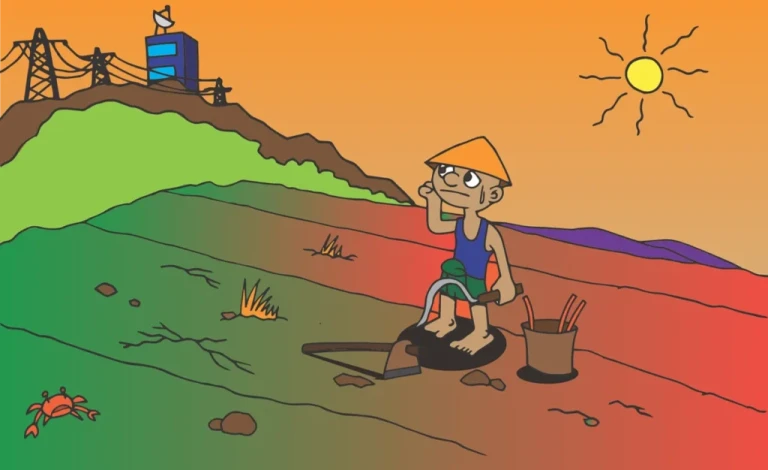What is Crop Insurance? & How does it Work?

Crop insurance is a type of insurance you can purchase to safeguard your crops against potential losses. When you buy it, you are guaranteed a payout if there is a loss on your property. It can help reduce the financial stress of having to replace crops due to a loss, and can also protect you from unexpected expenses such as damage to equipment or lost income.
What is Crop Insurance?
Crop insurance is a program that helps farmers cover the cost of lost crops, including both economic losses (due to price drops caused by bad weather) and non-economic losses (caused by pests or diseases).
Farmers typically buy Crop insurance before planting a particular crop, and the coverage can vary from year to year and from farm to farm. The main goal of insurance is to help farmers protect themselves from unexpected financial losses, especially during times of drought or other tough agricultural conditions.
While insurance is an important part of the agricultural landscape, it’s not without its challenges. For example, many farmers find it difficult to get comprehensive coverage for their crops due to limited provider options and high premiums. In addition, some critics argue that crop insurance has had negative impacts on the overall efficiency of the agricultural sector, by encouraging farmers to overproduce in order to secure coverage.
How does crop insurance work?
Crop insurance is a program that helps farmers cover the costs of lost or damaged crops. The government pays a portion of the claim, and the farmer receives a payout if the crop is covered by the policy.
The benefits of crop insurance include prevention of financial loss and peace of mind during uncertain times. Farmers can use insurance to protect against weather-related losses, such as hail, wind, and floods. Additionally, crop insurance can help cover potential price declines due to poor harvests.
It can be an important tool for farmers in both developed and developing countries. In developed countries, crop insurance subsidies help offset high premiums. In developing countries, insurance can help reduce vulnerability to shocks, such as drought or pests.
Why do you need Crop Insurance?
Crop insurance is a type of insurance that helps protect farmers from economic losses due to bad weather, such as a drought, flood, or tornado. Farmers may purchase insurance policies to cover their entire crop or specific types of crops.
Crop insurance can help protect farmers in a number of ways. For example, if there is a drought and the crops fail, the policy may help reimburse the farmer for lost revenue. In some cases, policies may also provide financial support for farmers who have to replant after a natural disaster.
Insurance policies are usually expensive, but they can be worth it if you experience major losses.
If you are interested in buying crop insurance, here are some tips:
-Look at the different types of coverage available and choose the type that is best for your farm.
-Select a policy with a low premium rate and make sure you understand all of the coverage details.
-Monitor weather conditions closely and decide whether to buy additional coverage if necessary.
How to claim Crop Insurance?
If you are a farmer, crop insurance is an important tool you can use to protect your crops from bad weather. It is government-backed insurance that pays farmers if their crops are damaged or lost due to natural disasters, such as floods, hurricanes, or tornadoes. Farmers typically buy insurance to cover the total cost of their losses, not just the value of their crops.
To claim crop insurance benefits, farmers must file a claim with their policy provider. The policy provider will then send out a claims adjuster to inspect the damage and determine whether benefits should be paid. If the adjuster decides that benefits should be paid, the policy provider will pay the farmer based on the terms of the policy.
There are several things you can do to help protect your crops from bad weather and make claiming crop insurance easier:
1. Make sure you are up-to-date on your production information.
This information is important for determining your coverage under a crop insurance policy.
2. Keep detailed records of all damage to your crops
This will help prove that your crops were damaged by a natural disaster. Additionally, it allows you to make a claim for benefits.
3. Avoid planting high-value crops near low-lying areas
This can increase your risk of damage from a natural disaster. By avoiding such areas, you can minimize the risks.
4. Plan for potential weather emergencies
Knowing how to protect your crops in the event of a natural disaster is key to successful crop insurance claims.
Types of Crop Insurance in India
Crop insurance is a form of insurance that protects farmers against losses caused by natural disasters such as floods, hailstorms and droughts. The policy pays out a predetermined amount of money to the farmer if there is a covered loss.
There are a number of different types of insurance policies available, and each has its own benefits and drawbacks. Here we take a look at some of the most popular types of crop insurance in India.
Liability Insurance:
This type of policy covers the farmer’s personal assets (such as crops, machinery and livestock) in the event of a covered loss. It is usually more expensive than other types of policies, but it provides greater protection.
Farmers can also choose to buy crop insurance with endorsements that provide additional coverage. Such as for buildings or for specific types of crops.
Crop Damage Waiver:
This type of policy doesn’t cover losses to the farmer’s personal assets, but instead covers only the value of crops damaged by a covered event. It’s usually cheaper than liability insurance, and it doesn’t require any proof of losses.
This policy is perfect for farmers who only suffer minor crop damage.
Insurance for Commercial Farmers:
This type of policy is designed specifically for commercial farmers. It provides greater coverage than most other types of policies, and it usually has higher premiums.
However, this policy is often easier to get than other types of insurance. Also, it can provide peace of mind in the event of a covered loss.
How to choose the best crop insurance?

Firstly, Consider the level of coverage you need. You can purchase insurance with either full coverage or partial coverage. Full coverage includes all potential losses, while partial coverage only covers certain losses. Partial coverage may be a better option if you have specific losses that you’re more likely to experience.
Next, you’ll want to determine your deductible. Your deductible is the amount of money you must pay before the insurance company will cover any losses. This is important because it allows you to spend less on insurance premiums and still protect your assets. The higher your deductible, the less money you will have to spend on claims in the event of a loss.
Finally, it’s important to carefully review each policy’s exclusions and limitations. These include things like acres covered and types of crops insured. Make sure that everything you need is covered by the policy before signing up.









